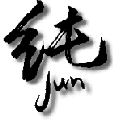|

|

| A |
B |
Item #: KEY7-A
Size: 3.6in(9cm)
Price: US$4.99 |
Item #: KEY7-B
Size: 3.2in(8cm)
Price: US$4.99 |
 |
 |
| C |
D |
Item #: KEY7-C
Size: 3.6in(9cm)
Price: US$4.99 |
Item #: KEY7-D
Size: 4in(10cm)
Price: US$5.50 |
NOT
AVAILABLE |
 |
 Item KEY7-C above and KEY8-D below Derived in design and function from the ancient Indian stupa built to enshrine the sacred remains or relics of the Buddha, the gojyu no to (pagoda) was a major religious architectural structure generally occupying a prominent place on temple grounds. From the introduction of Buddhism into Japan in the 6th century, many pagodas were built throughout the country. Over time, however, buildings other than the pagoda grew in stature and importance, resulting in the gojyu no to of today remaining more for their historical and decorative significance than for their practical value. It is unfortunate that many pagodas have been destroyed over the centuries by fire or war. Those still in existence attract thousands of visitors each year, among the most famous being the five-story pagoda located in Nara at Horyuji temple, whose wooden structures comprise the oldest wooden structures in the world; and Japan's tallest five-story pagoda found on the grounds of Toji temple in Kyoto. Item KEY7-C above and KEY8-D below Derived in design and function from the ancient Indian stupa built to enshrine the sacred remains or relics of the Buddha, the gojyu no to (pagoda) was a major religious architectural structure generally occupying a prominent place on temple grounds. From the introduction of Buddhism into Japan in the 6th century, many pagodas were built throughout the country. Over time, however, buildings other than the pagoda grew in stature and importance, resulting in the gojyu no to of today remaining more for their historical and decorative significance than for their practical value. It is unfortunate that many pagodas have been destroyed over the centuries by fire or war. Those still in existence attract thousands of visitors each year, among the most famous being the five-story pagoda located in Nara at Horyuji temple, whose wooden structures comprise the oldest wooden structures in the world; and Japan's tallest five-story pagoda found on the grounds of Toji temple in Kyoto.
|

Colors and patterns of the items below may vary.

Enlarge Image |

Enlarge Image |

Enlarge Image |
Hannya
Item #: KEY8-A
Size: 11.8in(30cm)
Price: US$6.99 |
Manekineko
Item #: KEY8-B
Size: 11in(28cm)
Price: US$6.99 |
Tsuru(Crane)
Item #: KEY8-C
Size: 9.8in(25cm)
Price: US$6.99 |
 |
 |
 |
| Colors and patterns of these items. |

Enlarge Image |

Enlarge Image |

Enlarge Image |
Gojyunoto
Item #: KEY8-D
Size: 11.8in(30cm)
Price: US$6.99 |
Shichifukujin
Item #: KEY8-E
Size: 10.5in(27cm)
Price: US$6.99 |
Item #: KEY8-F
Size: 5X3.5in(13X9cm)
Price: US$5.00
(set of two) |
 |
 |
NOT
AVAILABLE |
| Colors and patterns of these items. |

Enlarge Image |

Enlarge Image |

Enlarge Image |
Mikoshi
Item #: KEY8-G
Size: 10.5in(27cm)
Price: US$6.99 |
Tengu
Item #: KEY8-H
Size: 11.8in(30cm)
Price: US$6.99 |
Kozuchi
Item #: KEY8-I
Size: 11.8in(30cm)
Price: US$6.99 |
 |
 |
 |
| Colors and patterns of these items. |

Enlarge Image |

Enlarge Image |
|
Kinkakuji
Item #: KEY8-J
Size: 10.5in(27cm)
Price: US$6.99 |
Tawara
Item #: KEY8-K
Size: 9.8in(25cm)
Price: US$6.99 |
|
 |
 |
|
Colors and patterns of the items above may vary.
 These amulets (omamori) above would keep you safe from car accidents (and keep you away from
unfortunate events)and bring you a lot of happiness if they were real amulets;
unfortunately these are only replicas....but still makes a great keepsake,
doesn't it?. Almost all temples and shrines have amulets for sale. You
can buy different amulets for different purposes such as road safety for
your car, household safety, financial success and so forth. These amulets (omamori) above would keep you safe from car accidents (and keep you away from
unfortunate events)and bring you a lot of happiness if they were real amulets;
unfortunately these are only replicas....but still makes a great keepsake,
doesn't it?. Almost all temples and shrines have amulets for sale. You
can buy different amulets for different purposes such as road safety for
your car, household safety, financial success and so forth.
 |
 |

 |
Hannya: Possibly the most well-known demon, Hannya is a character that appears
in Japanese Noh and Bunraku plays. The fierce and grimacing expression
depicts anger, jealousy and hate. In recent years, hannya has been featured
on many items, as it is believed to protect people against evils. |
 |
Manekineko:The most famous cat in Japan - except for, of course, Hello Kitty - is
probably Manekineko. At the entrance (or inside) of restaurants, bars,
shops and other businesses that rely on heavy customer traffic you sometimes
see a porcelain figure in the shape of a sitting cat with one paw raised
as if making the customary Japanese gesture used in beckoning people. That
cat is the manekineko (beckoning cat) and believed to bring fortune and
happiness. |
 |
Tsuru(Crane):As the saying goes, ügTsuru ha sennen, kame ha mannenüh (The crane lives
a thousand years, and the turtle ten thousand). Tsuru (cranes) have long
been a symbol of longevity and prosperity, perhaps the most popular (and
auspicious) animal here in Japan. Crane designs have been used on many
items - everything from wrapping paper to furniture. |
 |
Gjyunoto:This is a miniature model of gojyunoto (five story pagoda). The pagoda
is a structure that evolved from the Indian stupa and generally has three
or five stories. It is said that pagodas store remains of the Buddha such
as a tooth, usually in form of a representation. |
 |
Shichifukujin (7 lucky gods): Shichifukujin is a group of 7 gods (and sages) of Chinese, Japanese and
Indian origin. They have been the symbol of good fortune and prosperity
and thus have been featured on many items, most often onboard a
ship called Takarabune (treasure ship). Dolls of the 7 gods are commonly
seen as well, especially in shops and restaurants. |
 |
Mikoshi:Mikoshi are ornate palanquins - like the portable shrine in which the
spirit of a shinto deity (kami sama) is believed to ride during festivals. It is
a necessary part of Japanese festivals and is carried around on the shoulders
of anywhere from 8-20 people in most cases. Usually it's the only time of yea r
when kami sama leaves the shrine. |
 |
Tengu: Tengu are a class of supernatural creatures found in Japanese folklore,
art and literature. Tengu were originally worshipped by yamabushi (mountain
ascetics) and depicted wearing yamabushi clothing. Tengu have a reddish
or blackish face and immensely long nose and carries a feathered fan.
|
 |
Uchide no kozuchi: Uchide no kozuchi can be translated as miracle mallet or small magic hammer. The mallet is said to be very small and swinging it brings good fortune and happiness. Daikokuten, one of the shichifukujin (7 lucky gods), holds this mallet. It also plays a very important role in the fairy tale of Issun boshi (Little One Inch) .
|
 |
Kinkakuji: This is Kinkakuji, the famous "Golden Pavilion" which is located in Kyoto. This was not a temple originally but a villa of Ashikaga Yoshimitsu, who
was a shogun in the 14th century. The original building was lost in a case of arson but rebuilt and was designated a World Heritage site in 1994. |
 |
Komedawara: This is a representation of rice bales. They are sometimes used as a symbol of rich harvest, fertility and prosperity. |
|
 |
If you would like to purchase more than one of a
particular item, please click on "Buy Now" link first and then
update the quantity in the shopping cart page.
|
| All prices are in US dollars |
| For details on payment methods, shipping rates and exchange policy, please
click on the information link at the top of the page. |
The color of the items in the pictures might slightly
differ from that of the actual items. |
|
|


























